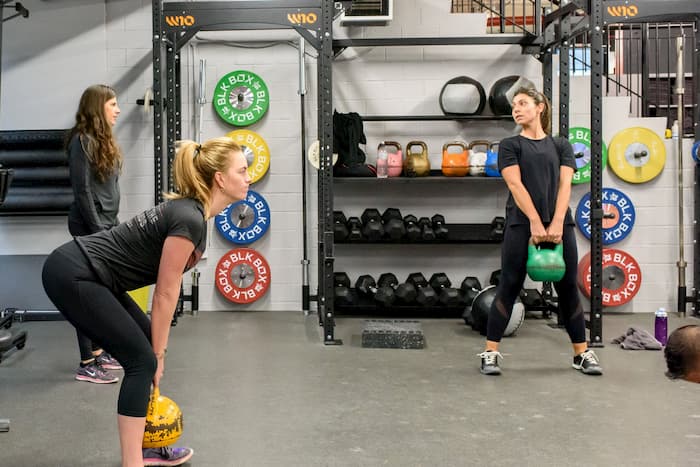
Categories
Hip Hinge Techniques
Incorporating the hip hinge into your fitness regimen is pivotal for a well-rounded training experience. This essential movement pattern promotes strength, core stability, body awareness, and increased mobility.
At Foundry, we ensure our members are coached to perform each exercise safely and correctly.
Why the Hip Hinge Technique Matters
The power of the hip hinge movement is rooted in its ability to activate critical muscle groups. Far from a simple bend, the hip hinge is central to exercises that engage the glutes, hamstrings, core, and lower back – all vital components of the ‘postural engine room’. This movement underpins functional daily activities and can significantly enhance posture, strength, and overall physical well-being.
Hip Hinges
It’s all in the hips!
The hip hinge stands tall alongside foundational movements like pushing, pulling, squatting, lunging, rotating, and even walking or running. Why? Because when we speak of hinging or bending, we’re discussing the activation and conditioning of core muscle groups. So, if your goals encompass improved mobility, better posture, or simply feeling and looking your best, integrating the hip hinge into your workouts is paramount.
Hip Hinge into Deadlifts
As we progress in our hip hinge series, our spotlight turns to deadlifts – an integral part of our training at Foundry. We’ll explore the nuances of two specific types: the trap bar deadlift and the traditional barbell deadlift. Both exercises, though different in execution, capitalise on the hip hinge’s fundamentals, enabling strength building and muscle engagement.
How’s your Hip Thrust?
In the concluding segment of our hip hinge journey, we introduce the dynamic kettlebell swing. Renowned for its explosive hip thrust motion, this exercise primarily targets the glutes and hamstrings. Optimising hip extension promises not just strength but an enhancement in speed and power, too.
Hip Hinge FAQs
Q: What is the hip hinge?
The hip hinge is a foundational movement pattern where the bend comes primarily from the hips rather than the spine. It emphasises the engagement of the posterior chain muscles, which include the glutes, hamstrings, and lower back.
Q: Why is the hip hinge crucial in fitness training?
The hip hinge promotes core stability, strength, body awareness, and mobility. It’s central to exercises that target vital muscle groups, ensuring effective glutes, hamstrings, core, and lower back activation. Proper hip hinge execution can also help prevent lower back injuries.
Q: How does the hip hinge differ from a squat?
While the hip hinge and squat are lower body movements, the primary difference lies in their focus. The hip hinge emphasises a backward motion of the hips with minimal knee bend, targeting the posterior chain. In contrast, the squat involves a deeper knee bend and a more vertical torso, emphasising the quadriceps more.
Q: Can beginners perform hip hinge exercises?
Absolutely! Like any new movement, beginners should start with foundational exercises to develop proper technique. Tools like dowels or broomsticks can be helpful to ensure alignment. Over time, as the movement becomes more familiar, resistance can be added.
Q: Are deadlifts and kettlebell swings the only exercises that use the hip hinge technique?
While deadlifts and kettlebell swings are popular exercises that incorporate the hip hinge, many others, like Romanian deadlifts, good mornings, and certain types of rows and pull-throughs.
Q: How can I ensure I’m performing the hip hinge correctly?
Maintaining a neutral spine and using tools like dowels to ensure alignment can be helpful. Initially, consider getting feedback from your fitness coach or using a mirror to check your form.
Q: Can the hip hinge help with posture issues?
Mastering the hip hinge can improve posture by strengthening the posterior chain, which is crucial in maintaining an upright position. Additionally, it teaches individuals to move through their hips, reducing undue stress on the lower back.
Q: How often should I incorporate hip hinge exercises into my routine?
This depends on your fitness goals. However, as the hip hinge targets essential muscle groups, incorporating it 2-3 times a week can benefit most individuals.
Q:. Is it normal to feel a stretch in the hamstrings during a hip hinge?
Yes, a proper hip hinge movement will stretch the hamstrings as you push your hips back. If you maintain a neutral spine, this indicates you’re hinging correctly.
Q: Can hip hinge exercises be modified for individuals with injuries or mobility issues?
Yes, there are various modifications and alternative exercises available. For instance, a chair or bench can guide the movement for those just starting or recovering from an injury.
If you have any questions on the above or would like some advice on how we could help you with your fitness goal, don’t hesitate to visit our gym and try one of our small group personal training sessions.
Related Articles
- Hip Hinge Your Way to a Longer Life
- Bodyweight Home Workout with a Resistance Band
- Spinal Mobility Exercises
- Kettlebell Exercises & Workout
- Kettlebell Workout: Build Your Glutes


